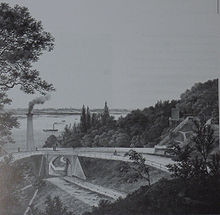Haddock tunnel
| Altona port railway tunnel | ||
|---|---|---|
|
Today closed south portal
|
||
| use | Railway tunnel | |
| traffic connection | Altona train station - Altona Kai | |
| place | Hamburg-Altona | |
| length | 961 m | |
| Number of tubes | 1 | |
| cross-section | oval | |
| construction | ||
| Client | Altona-Kiel Railway Company | |
| completion | 1876/1895 | |
| business | ||
| operator | Altona Harbor Railway | |
| release | 1876 | |
| closure | 1992 | |
| location | ||
|
|
||
| Coordinates | ||
| South portal | 53 ° 32 '43 " N , 9 ° 55' 58" E | |
| North portal | 53 ° 33 ′ 11 ″ N , 9 ° 56 ′ 9 ″ E | |
The Altona port railway tunnel (popularly: haddock tunnel ) is a disused, 961 m long railway tunnel in Hamburg-Altona . It connected the Hamburg-Altona train station with the tracks of the former Altona port railway and the Altona fishing port located below the Geesthang on the Elbe .
"Inclined plane"
The tunnel replaced an above-ground connection that was put into operation in 1845 to speed up the movement of goods between water and rail. At that time, the freight wagons were moved to roll stands and towed by cable lift - initially with a horse-drawn gopel , from 1849 with steam power - over a 210 m long inclined plane with a 15% gradient - to the station of the King Christian VIII Baltic Railway, which opened in 1844 . This elevator facility was in operation until 1879 and, like the railway line to Kiel, belonged to the Altona-Kiel Railway Company .
Tunnel course
The single-track tunnel was opened on January 18, 1876, initially with a length of 395 m between the banks of the Elbe and the Altona train station. He overcomes a height difference of 30 m. With the relocation of the Altona train station north to its current location, the tunnel was extended accordingly until 1895. It was used exclusively for freight transport. The northern mouth of the tunnel on the east side of the Altona train station has served as a truck access to the cellar of the neighboring department store since 1979 . It was one of the few underground level crossings in the world . The tunnel follows the main road Max-Brauer-Allee southwards to the New Altona Town Hall , shortly before it is crossed by the tunnel section ( City-S-Bahn ) of the S-Bahn . At the level of the former Altona train station (south wing of today's town hall), it swings to the southwest and shortly thereafter emerges below the Altona balcony on the steep slope of the Geest, where it is connected to the tracks in the port.
business
Between 1911 and 1954 the Altona port railway was electrified and also had an overhead line in the tunnel . However, the voltage in the damp tunnel was limited to 3 kV in order to avoid arcing and leakage currents .
At the beginning of the 1930s, the tunnel vault in the southern section, which originated in 1876, was completely renewed. During the air raids in World War II, the tunnel served many people in Altona unofficially as an air raid shelter .
After the last commercial user, Transthermos, relocated its operations in 1992 , the port railway was shut down and the tunnel at its south portal was closed with an iron grille. In 1998, due to the risk of collapse, the axle load was limited to the roads above it, and the tunnel was subsequently renovated, as this was more cost-effective than demolition or backfilling.
Reuse considerations
In the mid-1990s, a new business district was built in the area of the Altona harbor. In order to develop it, there was speculation about reactivating the tunnel for local public transport with lane buses , light rail vehicles or the like. A platform has already been erected on one of the new buildings and has been unused since then.
Due to the high costs and the unfavorable location to other means of transport, especially at the Altona train station, this was (initially) rejected after an investigation in April 2005. In September 2006, the then Altona district office manager Hinnerk Fock started a new attempt to reactivate the tunnel runway. A good year later, an appraisal from the Technical University of Harburg came to the conclusion that it was not economical to operate local public transport in the tunnel. However, there are still isolated requests for reactivation today.
literature
- Culture Authority Hamburg (ed.): The port railway tunnel in Altona. Self-published, Hamburg 1993.
- Erich Staisch (ed.): The train to the north. 150 years of rail traffic in Schleswig-Holstein. E. Kabel, Hamburg 1994, ISBN 3-8225-0298-7 , esp. Pp. 40–45, chapter "The Altonaer Hafenbahn"
- Association for the Rescue of the Port Railway Hamburg-Altona eV (ed.): The haddock tunnel should live! Self-published, Hamburg-Altona 1994, expanded new edition by the Hamburg Cultural Authority, 1993
- Ulrich Alexis Christiansen: Hamburg's dark worlds. The mysterious underground of the Hanseatic city. Ch.Links, Berlin 2008, ISBN 3-8615-3473-8
Web links
- The haddock tunnel - (not) a ghost tunnel in Altona?
- Altona port railway tunnel at geschichtsspuren.de (formerly lostplaces.de)
- Images of the tunnel portals
Individual evidence
- ^ NDR: Schellfisch Tunnel Altona: No train will come (October 7, 2011)
- ↑ Hamburger Abendblatt: Out for the haddock tunnel in Altona (November 9, 2007)



